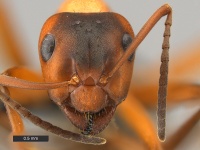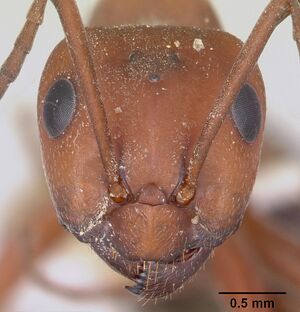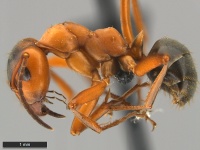Formica rubicunda
| Formica rubicunda | |
|---|---|

| |
| Scientific classification | |
| Kingdom: | Animalia |
| Phylum: | Arthropoda |
| Class: | Insecta |
| Order: | Hymenoptera |
| Family: | Formicidae |
| Subfamily: | Formicinae |
| Tribe: | Formicini |
| Genus: | Formica |
| Species: | F. rubicunda |
| Binomial name | |
| Formica rubicunda Emery, 1893 | |
This species nests under stones and logs and may occasionally construct thatched nests or earthen mounds. Formica rubicunda enslaves Formica altipetens, Formica bradleyi, Formica fossaceps, Formica lasioides, Formica lepida, Formica montana, Formica neoclara, Formica neogagates, Formica neorufibarbis, Formica obscuriventris, Formica pallidefulva and Formica subsericea. One mixed nest included Formica argentea, Formica aserva, Formica obtusopilosa Formica lasioides and a Myrmica species.
| At a Glance | • Dulotic |
Photo Gallery
 Formica rubicunda and host Formica subsericea, eastern Missouri oak woodland. Photo by James Trager.
Formica rubicunda and host Formica subsericea, eastern Missouri oak woodland. Photo by James Trager.
Identification
The apex of the petiole, as seen in profile, is sharp. The dorsum of the first tergum of the gaster has abundant hairs, slightly over 0.1 mm in length. The hairs are coarse and thick, but most are abruptly tapered to sharp tips. These hairs are slightly longer and more abundant than those on the pronotum, which tend to be more blunt tipped. The underside of the head usually has four hairs. (Mackay and Mackay 2002)
Keys including this Species
Distribution
Widespread in North America.
Latitudinal Distribution Pattern
Latitudinal Range: 48.63° to 24.83444444°.
| North Temperate |
North Subtropical |
Tropical | South Subtropical |
South Temperate |
- Source: AntMaps
Distribution based on Regional Taxon Lists
Nearctic Region: Canada, United States (type locality).
Neotropical Region: Mexico.
Distribution based on AntMaps
Distribution based on AntWeb specimens
Check data from AntWeb
Countries Occupied
| Number of countries occupied by this species based on AntWiki Regional Taxon Lists. In general, fewer countries occupied indicates a narrower range, while more countries indicates a more widespread species. |

|
Estimated Abundance
| Relative abundance based on number of AntMaps records per species (this species within the purple bar). Fewer records (to the left) indicates a less abundant/encountered species while more records (to the right) indicates more abundant/encountered species. |

|
Habitat
In New Mexico (Mackay and Mackay 2002) - Prairies and open woodlands up to pinyon-juniper and ponderosa pine and aspen forests.
Biology
This species is a member of a group of Formica species that were formerly placed in the subgenus Raptiformica. All species are facultative slavemakers, i.e., species which usually or often have slaves but can get along without them. The colony-founding female forces her way into a small colony of another species of Formica, somehow gets rid of its queen and workers and appropriates its nest and brood. The workers emerging from this brood accept the intruding queen as their own. The enslaved species belong to the Formica neogagates, fusca, and pallidefulva species groups. When the workers of the slave-making species have become numerous enough, they start raiding for more slaves.
Formica rubicunda is known to enslave the following species:
- Formica altipetens
- Formica argentea
- Formica aserva
- Formica bradleyi (doubtful, slave maker possibly Formica pergandei)
- Formica fossaceps
- Formica lasioides
- Formica lepida
- Formica montana
- Formica neoclara
- Formica neogagates
- Formica neorufibarbis
- Formica obscuriventris
- Formica obtusopilosa
- Formica pallidefulva
- Formica subaenescens
- Formica subsericea
- Myrmica
Association with Other Organisms
 Explore: Show all Associate data or Search these data. See also a list of all data tables or learn how data is managed.
Explore: Show all Associate data or Search these data. See also a list of all data tables or learn how data is managed.
- This species is a mutualist for the aphid Rhopalosiphum nymphaeae (a trophobiont) (Jones, 1927; Saddiqui et al., 2019).
- This species is a host for the braconid wasp Elasmosoma petulans (a parasitoid) (Quevillon, 2018) (encounter mode primary; direct transmission; transmission outside nest).
Flight Period
| X | |||||||||||
| Jan | Feb | Mar | Apr | May | Jun | Jul | Aug | Sep | Oct | Nov | Dec |
Source: antkeeping.info.
- Check details at Worldwide Ant Nuptial Flights Data, AntNupTracker and AntKeeping.
 Explore: Show all Flight Month data or Search these data. See also a list of all data tables or learn how data is managed.
Explore: Show all Flight Month data or Search these data. See also a list of all data tables or learn how data is managed.
Castes
Worker
Images from AntWeb
   
| |
| Worker. Specimen code casent0104884. Photographer April Nobile, uploaded by California Academy of Sciences. | Owned by CAS, San Francisco, CA, USA. |
Images from AntWeb
   
| |
| Worker. Specimen code casent0104869. Photographer April Nobile, uploaded by California Academy of Sciences. | Owned by CAS, San Francisco, CA, USA. |
Nomenclature
The following information is derived from Barry Bolton's Online Catalogue of the Ants of the World.
- rubicunda. Formica sanguinea subsp. rubicunda Emery, 1893i: 647, pl. 22, fig. 2 (w.q.) U.S.A. Wheeler, W.M. 1913f: 407 (m.). Combination in F. (Raptiformica): Emery, 1925b: 260. Raised to species: Creighton, 1950a: 468. Junior synonym of subintegra: Wilson & Brown, 1955: 120. Revived from synonymy: Buren, 1968a: 30.
Description
References
- Borowiec, M.L., Cover, S.P., Rabeling, C. 2021. The evolution of social parasitism in Formica ants revealed by a global phylogeny. Proceedings of the National Academy of Sciences 118, e2026029118 (doi:10.1073/pnas.2026029118).
- Buren, W. F. 1968a. Some fundamental taxonomic problems in Formica (Hymenoptera: Formicidae). J. Ga. Entomol. Soc. 3: 25-40 (page 30, Revived from synonymy)
- Cantone S. 2018. Winged Ants, The queen. Dichotomous key to genera of winged female ants in the World. The Wings of Ants: morphological and systematic relationships (self-published).
- Carroll, T.M. 2011. The ants of Indiana (Hymenoptera: Formicidae). M.S. thesis, Purdue University.
- Creighton, W. S. 1950a. The ants of North America. Bulletin of the Museum of Comparative Zoology 104: 1-585 (page 468, raised to species)
- Emery, C. 1893k. Beiträge zur Kenntniss der nordamerikanischen Ameisenfauna. Zool. Jahrb. Abt. Syst. Geogr. Biol. Tiere 7: 633-682 (page 647, pl. 22, fig. 2 worker, queen described)
- Emery, C. 1925d. Hymenoptera. Fam. Formicidae. Subfam. Formicinae. Genera Insectorum 183: 1-302 (page 260, Combination in F. (Raptiformica))
- Ipser, R.M., Brinkman, M.A., Gardner, W.A., Peeler, H.B. 2004. A survey of ground-dwelling ants (Hymenoptera: Formicidae) in Georgia. Florida Entomologist 87: 253-260.
- Ivanov, K. 2019. The ants of Ohio (Hymenoptera, Formicidae): an updated checklist. Journal of Hymenoptera Research 70: 65–87 (doi:10.3897@jhr.70.35207).
- MacGown, J.A., Booher, D., Richter, H., Wetterer, J.K., Hill, J.G. 2021. An updated list of ants of Alabama (Hymenoptera: Formicidae) with new state records. Transactions of the American Entomological Society 147: 961-981 (doi:10.3157/061.147.0409).
- Mackay, W. P. and E. Mackay. 2002. The ants of New Mexico (Hymenoptera: Formicidae). Edwin Mellen Press, Lewiston, NY.
- Siddiqui, J. A., Li, J., Zou, X., Bodlah, I., Huang, X. 2019. Meta-analysis of the global diversity and spatial patterns of aphid-ant mutualistic relationships. Applied Ecology and Environmental Research 17: 5471-5524 (doi:10.15666/aeer/1703_54715524).
- Wheeler, W. M. 1913i. A revision of the ants of the genus Formica (Linné) Mayr. Bulletin of the Museum of Comparative Zoology 53: 379-565 (page 407, male described)
- Wilson, E. O.; Brown, W. L., Jr. 1955. Revisionary notes on the sanguinea and neogagates groups of the ant genus Formica. Psyche (Camb.) 62: 108-129 (page 120, Junior synonym of subintegra)
References based on Global Ant Biodiversity Informatics
- Borchert, H.F. and N.L. Anderson. 1973. The Ants of the Bearpaw Mountains of Montana (Hymenoptera: Formicidae). Journal of the Kansas Entomological Society 46(2):200-224
- Buren W. F. 1941. A preliminary list of Iowa ants. Iowa State College Journal of Science 15: 111-117
- Buren W. F. 1944. A list of Iowa ants. Iowa State College Journal of Science 18:277-312
- Campbell K. U., and T. O. Crist. 2017. Ant species assembly in constructed grasslands isstructured at patch and landscape levels. Insect Conservation and Diversity doi: 10.1111/icad.12215
- Carroll T. M. 2011. The ants of Indiana (Hymenoptera: Formicidae). Master's Thesis Purdue university, 385 pages.
- Choate B., and F. A. Drummond. 2012. Ant Diversity and Distribution (Hymenoptera: Formicidae) Throughout Maine Lowbush Blueberry Fields in Hancock and Washington Counties. Environ. Entomol. 41(2): 222-232.
- Choate B., and F. A. Drummond. 2013. The influence of insecticides and vegetation in structuring Formica Mound ant communities (Hymenoptera: Formicidae) in Maine lowbush blueberry. Environ. Entomol. 41(2): 222-232.
- Clark Adam. Personal communication on November 25th 2013.
- Coovert G. A. 2005. The Ants of Ohio (Hymenoptera: Formicidae). Ohio Biological Survey, Inc. 15(2): 1-207.
- Coovert, G.A. 2005. The Ants of Ohio (Hymenoptera: Formicidae) Ohio Biological Survey Bulletin New Series Volume 15(2):1-196
- Del Toro I., K. Towle, D. N. Morrison, and S. L. Pelini. 2013. Community Structure, Ecological and Behavioral Traits of Ants (Hymenoptera: Formicidae) in Massachusetts Open and Forested Habitats. Northeastern Naturalist 20: 1-12.
- Del Toro, I. 2010. PERSONAL COMMUNICATION. MUSEUM RECORDS COLLATED BY ISRAEL DEL TORO
- Dubois, M.B. and W.E. Laberge. 1988. An Annotated list of the ants of Illionois. pages 133-156 in Advances in Myrmecology, J. Trager
- Forster J.A. 2005. The Ants (hymenoptera: Formicidae) of Alabama. Master of Science, Auburn University. 242 pages.
- General D., and L. Thompson. 2008. New distributional records of ants in Arkansas. Journal of the Arkansas Academy of Science 62: 148-150.
- Glasier J. R. N., J. H. Acorn, S. E. Nielsen, and H. Proctor. 2013. Ants (Hymenoptera: Formicidae) of Alberta: A key to species based primarily on the worker caste. Canadian Journal of Arthropod Identification 22: 1-104.
- Gregg, R.T. 1963. The Ants of Colorado.
- Guénard B., K. A. Mccaffrey, A. Lucky, and R. R. Dunn. 2012. Ants of North Carolina: an updated list (Hymenoptera: Formicidae). Zootaxa 3552: 1-36.
- Ipser R. M. 2004. Native and exotic ants (Hymenoptera: Formicidae) of Georgia: Ecological Relationships with implications for development of biologically-based management strategies. Doctor of Philosophy thesis, University of Georgia. 165 pages.
- Ipser, R.M., M.A. Brinkman, W.A. Gardner and H.B. Peeler. 2004. A Survey of Ground-Dwelling Ants (Hymenoptera: Formicidae) in Georgia. The Florida Entomologist 87(3) 253-260.
- Ivanov, K. 2019. The ants of Ohio (Hymenoptera, Formicidae): an updated checklist. Journal of Hymenoptera Research 70: 65–87.
- Ivanov K., L. Hightower, S. T. Dash, and J. B. Keiper. 2019. 150 years in the making: first comprehensive list of the ants (Hymenoptera: Formicidae) of Virginia, USA. Zootaxa 4554 (2): 532–560.
- King R. L. and R. M. Sallee. 1964. Notes on Iowa ants. Iowa Academy of Science. 71: 484-485
- Lessard, J.-P., R. R. Dunn and N. J. Sanders. 2009. Temperature-mediated coexistence in temperate forest ant communities. Insectes Sociaux 56(2):149-456.
- Longino, J.T. 2010. Personal Communication. Longino Collection Database
- Lubertazi, D. Personal Communication. Specimen Data from Museum of Comparative Zoology at Harvard
- Lynch J. F. 1988. An annotated checklist and key to the species of ants (Hymenoptera: Formicidae) of the Chesapeake Bay region. The Maryland Naturalist 31: 61-106
- MacGown, J.A and J.A. Forster. 2005. A preliminary list of the ants (Hymenoptera: Formicidae) of Alabama, U.S.A. Entomological News 116(2):61-74
- MacGown, J.A. and JV.G. Hill. Ants of the Great Smoky Mountains National Park (Tennessee and North Carolina).
- Mackay W. P., and E. E. Mackay. 2002. The ants of New Mexico (Hymenoptera: Formicidae). Lewiston, New York: Edwin Mellen Press, 400 pp.
- Martelli, M.G., M.M. Ward and Ann M. Fraser. 2004. Ant Diversity Sampling on the Southern Cumberland Plateau: A Comparison of Litter Sifting and Pitfall Trapping. Southeastern Naturalist 3(1): 113-126
- Menke S. B., E. Gaulke, A. Hamel, and N. Vachter. 2015. The effects of restoration age and prescribed burns on grassland ant community structure. Environmental Entomology http://dx.doi.org/10.1093/ee/nvv110
- Menke S. B., and N. Vachter. 2014. A comparison of the effectiveness of pitfall traps and winkler litter samples for characterization of terrestrial ant (Formicidae) communities in temperate savannas. The Great Lakes Entomologist 47(3-4): 149-165.
- Michigan State University, The Albert J. Cook Arthropod Research Collection. Accessed on January 7th 2014 at http://www.arc.ent.msu.edu:8080/collection/index.jsp
- Sturtevant A. H. 1931. Ants collected on Cape Cod, Massachusetts. Psyche (Cambridge) 38: 73-79
- Talbot M. 1976. A list of the ants (Hymenoptera: Formicidae) of the Edwin S. George Reserve, Livingston County, Michigan. Great Lakes Entomologist 8: 245-246.
- Wang C., J. Strazanac and L. Butler. 2000. Abundance, diversity and activity of ants (Hymenoptera: Formicidae) in oak-dominated mixed Appalachian forests treated with microbial pesticides. Environmental Entomology. 29: 579-586
- Wheeler G. C., J. N. Wheeler, and P. B. Kannowski. 1994. Checklist of the ants of Michigan (Hymenoptera: Formicidae). The Great Lakes Entomologist 26(4): 297-310
- Wheeler G. C., and E. W. Wheeler. 1944. Ants of North Dakota. North Dakota Historical Quarterly 11:231-271.
- Wheeler G. C., and J. Wheeler. 1987. A Checklist of the Ants of South Dakota. Prairie Nat. 19(3): 199-208.
- Wheeler W. M. 1900. The habits of Ponera and Stigmatomma. Biological Bulletin (Woods Hole). 2: 43-69.
- Wheeler W. M. 1906. Fauna of New England. 7. List of the Formicidae. Occasional Papers of the Boston Society of Natural History 7: 1-24
- Wheeler W. M. 1906. Fauna of New England. 7. List of the Formicidae. Occasional Papers of the Boston Society of Natural History 7: 1-24.
- Wheeler W. M. 1913. A revision of the ants of the genus Formica (Linné) Mayr. Bulletin of the Museum of Comparative Zoology 53: 379-565.
- Wheeler, G.C. and J. Wheeler. 1988. A checklist of the ants of Montana. Psyche 95:101-114
- Wheeler, G.C. and J. Wheeler. 1988. A checklist of the ants of Wyoming. Insecta Mundi 2(3&4):230-239
- Wheeler, G.C., J. Wheeler and P.B. Kannowski. 1994. CHECKLIST OF THE ANTS OF MICHIGAN (HYMENOPTERA: FORMICIDAE). Great Lakes Entomologist 26:1:297-310
- Wing M. W. 1939. An annotated list of the ants of Maine (Hymenoptera: Formicidae). Entomological News 50:161-165.
- Pages using DynamicPageList3 parser function
- Dulotic
- Photo Gallery
- North temperate
- North subtropical
- Ant Associate
- Host of Formica altipetens
- Host of Formica argentea
- Host of Formica aserva
- Host of Formica bradleyi
- Host of Formica fossaceps
- Host of Formica lasioides
- Host of Formica lepida
- Host of Formica montana
- Host of Formica neoclara
- Host of Formica neogagates
- Host of Formica neorufibarbis
- Host of Formica obscuriventris
- Host of Formica obtusopilosa
- Host of Formica pallidefulva
- Host of Formica subaenescens
- Host of Formica subsericea
- Host of Myrmica
- Aphid Associate
- Host of Rhopalosiphum nymphaeae
- Braconid wasp Associate
- Host of Elasmosoma petulans
- FlightMonth
- Species
- Extant species
- Formicidae
- Formicinae
- Formicini
- Formica
- Formica rubicunda
- Formicinae species
- Formicini species
- Formica species
- Sanguinea group


